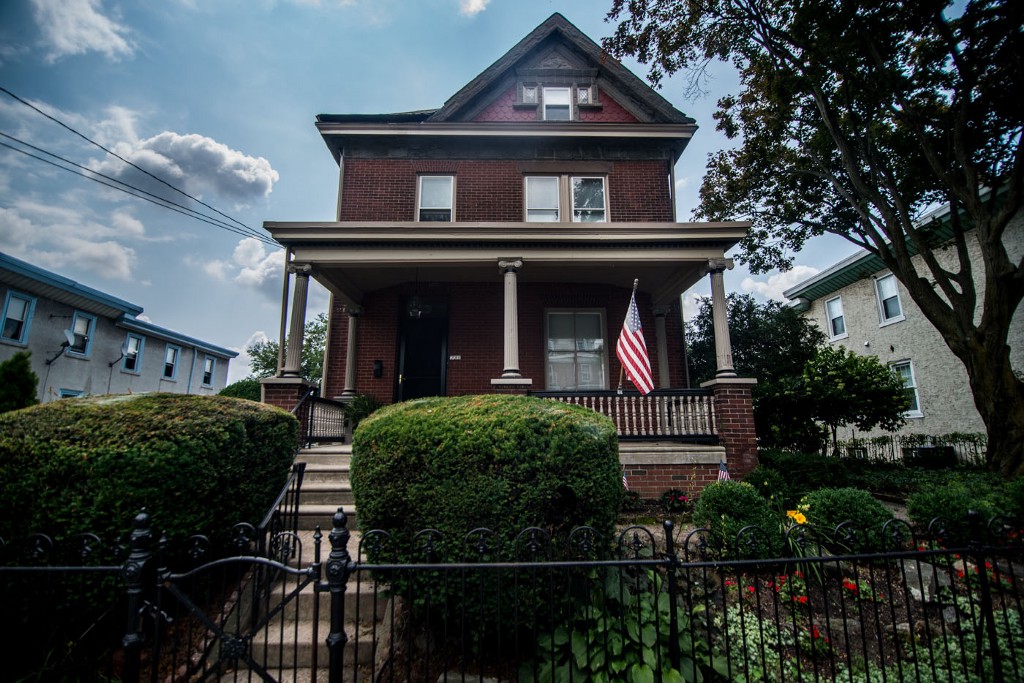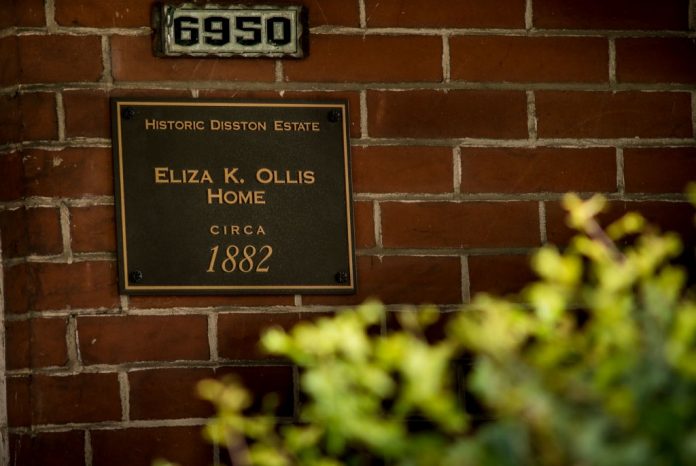Houses with history: A home on Hegerman Street is one of 22 properties that had plaques with information about the building’s dates and original owners installed.
History is leaving its mark, well, marks, in Tacony.
Over the past few years, the Historical Society of Tacony has placed permanent bronze markers on more than a score of neighborhood homes that date back to the 19th century as the area was developed for the employees of the Disston Saw Works.
Twenty-two plaques with information about the building’s dates and original owners have been installed in what could be called the core of the 1,500 parcels of the Mary Disston Estate in Tacony, said Louis M. Iatarola, a historical society board member.
Henry Disston, founder of the Disston Saw Works, began relocating his company to Tacony from Northern Liberties in the 1870s. He and his wife, Mary, believed Tacony could be developed into an ideal community of affordable homes for the company’s workers.
The couple created the Mary Disston Estate to purchase land and build houses for Disston employees. After Henry Disston died in 1878, his widow pursued this vision, donating land for schools, churches and parks. After Mary Disston died in 1895, an estate trust carried on that work in Tacony until 1940.
There’s a lot of interest in the neighborhood’s history, Iatarola said, but there’s more than that.
“We definitely have a pride of place here,” he said, “and that’s what we’re reinforcing.”
A 23rd plaque is expected to be up before summer’s end, Iatarola said.
More are coming. “We hope to have [a total of] 33 plaques this time next year,” Iatarola said.
Local historians Patty and Jack McCarthy researched the properties and wrote reports on them.
Information on who built a house and when it was built most often isn’t in one place, like a deed, Jack McCarthy said in a July 18 phone interview. A lot of the old deeds are difficult to read. City maps and atlases have to be consulted. Old pre-telephone directories of Philadelphia citizens have to be searched, and Census data has to be scoured.
“It took time, effort and know-how,” Patty McCarthy said. It could take 50 hours of work for some properties, she said.
Researchers sometimes couldn’t get exact dates.
The Christopher Eisenhardt house at 7013 Tulip was built around 1900.
“Sometimes, a property was purchased before it was built on,” she said. “So you don’t have an exact date.”
The 1880 census shows the Eisenhardt family lived on Tulip Street, but not at that address, she said.
Addresses in the north and south streets haven’t changed, but in the 1920s some of the numbers on the east and west streets were altered, Iatarola said. For example, the 3500 block of Longshore is now the 4700 block.
PRESERVING HISTORY
The historical society’s plaque program started with a grant application, Iatarola said during a July 17 phone interview. The society’s longer-range goal is to have the neighborhood designated a National Historic District.
The society worked with the Preservation Alliance, a nonprofit that oversees historical-related issues in Philadelphia, to identify a historic core of Tacony: The 6900 and 7000 blocks of Keystone and Tulip (Longshore to Princeton), the 6900 block of Hegerman, and the 4800 and 4900 blocks of Disston, Longshore and Tyson.
Owners of homes in that pilot area that were built by 1920 were contacted and asked if they wanted to kick in half of the $550 per plaque cost.
Response was heavy and quick, Iatarola said. The society had funding for 15 9-inch-by-12-inch plaques, he said, but so many homeowners wanted one that a waiting list had to be created.
“We’ve been happy with the response,” Iatarola said. “I’ve experienced an overwhelming pride in Tacony.”
The information for each plaque is researched, he said, and a report comes with each installation that tells the current homeowner when the house was built and for whom. The chain of ownership also is outlined.
The society, with City Councilman Bobby Henon’s help, applied for and got a Philadelphia Activities Grant to put up eight more. The society is applying for more grant money to get 10 additional plaques.
BARS BARRED
The Disston Estate has a deed restriction, Iatarola said, that prohibits alcohol sales. There are bars in the larger neighborhood, but you can almost see the Disston Estate boundaries by where the taverns begin to show up, Iatarola said.
Recognizing Tacony as a very different part of Philadelphia is the reason the historical society was formed in 1990 and the historical designations have been sought, he said.
Tacony History Day became an annual neighborhood event for celebrating the area’s unique standing in the city. That’s been suspended for the past few years, Iatarola said, as the society pursued the plaque program and national historic designation.
A consultant was hired to help, grants were obtained and donations from residents and businesses were sought.
All of that led to a report that will be submitted to the Pennsylvania Historical Museum Commission in September. The commission moves along requests for national historic designations.
Such national recognition, Iatarola said, “helps to reinforce this is a different place within the city … and has historic significance.”
Lots of money has been needed to push the cause, Iatarola said.
A big contributor has been Port Richmond Savings, which kicked in $20,000. Anyone interested in Tacony history can help out, Iatarola said. Checks payable to the Historical Society of Tacony can be mailed to the organization at 4819 Longshore Ave., Philadelphia, PA 19135. ••

Houses with history: A home on Tulip Street is one of 22 properties that had plaques with information about the building’s dates and original owners installed. MARIA POUCHNIKOVA / TIMES PHOTOS





